|
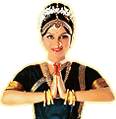 |
|
Welcome |
|
Rajasthan
Tours |
|
|
|
|
|
|
|
|
|
|
|
|
|
|
|
|
|
|
|
|
|
|
|
|
|
|
|
|
|
|
|
|
Introduction of Dholpur |
|
District
Dholpur is situated in the eastern part of Rajasthan. The present name
is said to have been derived from Dhaulpur as a separate district came
into existence in 1982 comprising four tehsils of Bharatpur namely
Dholpur, Rajakhera, Bari and Baseri.
It is bordered by Bharatpur district of Rajasthan and Uttar Pradesh to
the north, Madhya Pradesh to the south, Karauli district to the west
and Uttar Pradesh and Madhya Pradesh to the east.
The District has four Subdivisions and four development Blocks namely
Dholpur, Bari, Baseri and Rajakhera. The district is well connected by
roads and railways. The Broad-gauge lines of Mumbai – Agra of Central
Railways, passes through the district headquarter Dholpur. |
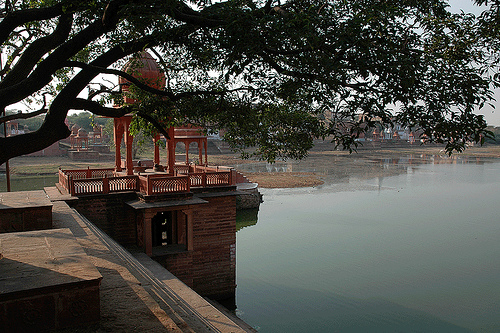
Mach Kund |
|
|
|
History of Dholpur |
|
Dholpur
according to the Epics was initially known as Dhawalgiri and later on
Dhaulagir, and now as Dholpur. Before the battle of Mahabharat this
whole area was under the Yadavs. Whose different branches were spread
over the entire area extending from the south of the river Chambal.
There is a common belief that some of the Aryan races also lived in
this part. Col. James Todd in his book ‘Annals and Antiquities of
Rajputana’ has mentioned that the area was submerged under sea during
the Ramayan period.
The key to the ancient history of Dholpur is the ruins of strength
fort which is situated on the bank of river Chambal. According to the
Modern Review’s Hindi edition Vishal Bharat published during 1957. The
author in one of its edition has linked Dholpur to the period of Lord
Vishnu. According to him the present fort was the seat of lord Vishnu
and all around was water. Looking at the condition of the fort it
appears that it is very ancient but its age can only be ascertained by
chemical analysis.
During the second phase of ancient history, the ruins of Mahabharat
period could be seen and around the temple of Muchukund ji. According
to the Shastras Muchukund was a very illustrious king before Krishna.
During the war between Devtas and Danavas, King Muchukund sided with
the devtas and was instrumental in their victory. Indra was so pleased
was that he asked Muchukund to have a boon. Muchukund was so tired
that he asked Indra to allow him to sleep peacefully and if anyone
should wake him up, Muchukund’s angry gaze would burn him to ashes.
Mahabharat reveals that during one of the battles with the demons
Krishna ran away to save his life from one of the demons and came to
the spot where Muchukund was sleeping. He put his pitamber on the
sleeping Muchukund. The demon thinking him to be Krishna woke him up,
and thus the demon was burnt to ashes, and thus the life of Krishna
was saved. The event took place, in a spot very near to the Muchukund
Ji’s temple, where the ruins of old palaces still exist. The
appearance of these, however does not seem to be that old.
The archaeological investigations in the district have pushed his
history back to the Stone Age. Hence, no Palaeoliths have been
reported from this area as so far. Microlithic tools were reported
from Hansai, Nand-ka-pura in Tehsil Bari ; Tor Danyal in Tehsil
Dholpur and Karka Kherli in Tehsil Rajakhera which suggest that the
district inhavited by the microlithick people in large. Painted Grey
Ware are reported from Bari, Donder Khera, Hansai in Tehsil Bari ;
Kolwa, Saipau and Son in Tehsil Dholpur ; Karka Kherli and Ghari in
the Tehsil Rajakhera datable to second and first millennium B.C. early
Historical and historical pottery has also been found from this area.
A trial trench excavation at Donder khera in Tehsil Bari has yielded
long cultural sequences from Chalcolithic to Muslim period. The
excavation has revealed Black and Red ware of Chalcolithic period
followed by the Painted Grey Ware and Black Slipped Ware with
associated red ware. Three different phases of structural activities
have been noticed in a small operational area during excavation. These
structures are part of residential apartments. The wall of the house
was built of burnt bricks. The pottery assemblage of the site
comprised of red slipped ware, stamped-pottery and coarse red ware,
are in varied types included footed-bowls, sharp-edged bowls, vases,
dishes, miniature vases, carinated handi, storage jars etc. Among the
antiquities the figure of Ganesa and Jaina Tirthankara, terracotta and
stone hopcoches, a copper bangle piece, iron knife and a fragment of
stone sculpture are noteworthy. The antiquities can be datable to
pre-Gupta period, and the site remained under the occupation up to the
late mediaeval period.
The Brahmnism and Jainism both were prevailing in the society during
the early mediaval period. The discoveries of Naga and Nagis figures
from Dholpur put the considerable influence of Nagavansies of
Padamvaties over this area. They were succeeded by Guptas as evidences
reported from the excavations at Donder Khera. The figures of Nagas
and Nagis sculptures are belong to tenth to twelfth century A.D. An
eleventh century panchayatana temple called as Jogni-Jogana situated
near Sone-ka-Gurja is an important edifice of this period.
There are many places of tourist importance belonging to medieval
period like Shergarh fort, Muchkund, Sikargarh at Bari, Baber’s garden
at Jhor, Maharajwada Purani Chhavni, Tomb of Zar-Zarina at Dhlopur are
important among them.
The history of Dholpur that has travelled down to us covers an
important era in the annals of Rajasthan extending from 563 B.C. to
this date.
|
|
Tourist Attraction in Dholpur |
|
Laswari
Laswari is a historical site of Dholpur where Daulat Rao
Scindia was defeated by Lord Lake. You could see the ruins of the
oldest Mughal garden, the
Damoh Waterfall and the Kanpur Mahal. They all form a
beautiful piece of attractions at Laswari. There are various
other places like Bari, Talab-e Shahi lake, Van Vihar
Wildlife Sanctuary and Ram Sagar Sanctuary
Shergarh Fort
Situated south of Dholpur, is the Shergarh Fort which was
constructed by Sher Shah Suri on the ruines of Hindu Fortress.
The Khanpur Mahal
This was a pleasure house for Mughal Emperor Shah Jahan. The
exquisite structure of the Khanpur Mahal tends to lure number of
travellers.
The Shiva Temple
This is a historical monuments which boast great
architectural beauty of all times. The shiva temple is located near
the Gwalior Agra Road. |
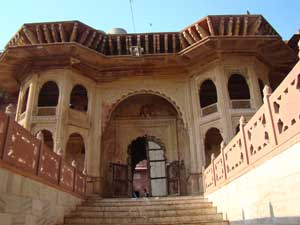 |
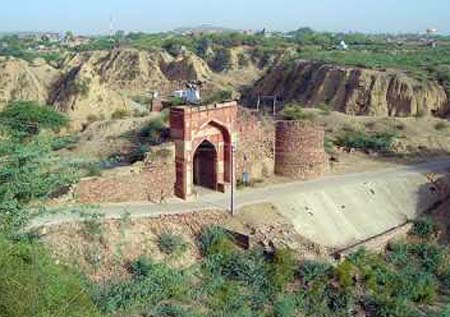 |
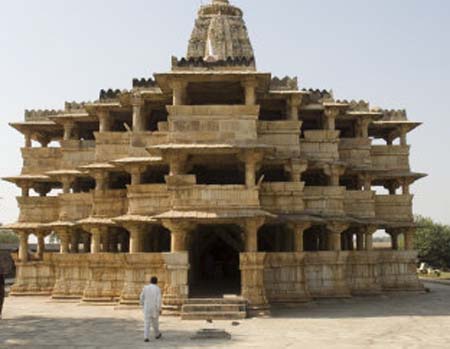 |
|
Saipau Fort |
Shergarh Fort |
The Shiva Temple |
|
|
How to get here |
|
By Rail:
Dholpur district is well connected with both meter gauge and broad
gauge rail routes with Agra, Gwalior, Bharatput and Sawai Madhopur
etc.
By Road:
Dholpur district is located on National Highway No.3. The important
towns of the district are well connected with metalled roads and state
highways. Agra (50 kms) from Dholpur. |
Dholpur, 113 km. (70 miles) by road from Bharatpur, and 230 km. (143
miles) from Delhi by rail is famous for its game sanctuary and
historical associations. In the Van Vihar game sanctuary around Ram
Sagar tank, one may see tigers and other wild animals moving about
freely in their habitat.
It was
near Dholpur that two important Mughul wars of succession were fought.
When Shah Jahan fell ill, his eldest and most beloved son, Dara Shikoh
was defeated by his younger brother Aurangzeb in 1658 at Ran-ka-Chabutra,
5 km. (3 miles) east of Dholpur. Again, on Aurangzeb’s death in 1707,
his sons, Azam and Muazzam, fought a battle at Baretha where the
former was killed and the latter became the emperor under the title of
Bahadur Shah.
The
monuments at Dholpur include the Shergarh fort built by Sher Shah Suri
on the site of an earlier Hindu fortress. The Khanpur Mahal,
consisting of several charming pavilions, was constructed as a
pleasure-palace for Shah Jahan. There are about 20 octagonal chhatris
of red sandstone near the picture-sque Talab Shahi tank which is a
fine breeding place for ducks.
|
|
You will visit
“Dholpur”
during the below Tour of Rajasthan. |
|
 31 Days Rajasthan Tour
(Including Dholpur)
31 Days Rajasthan Tour
(Including Dholpur)

31 Days / 30 Nights
Delhi - Alwar - Deeg - Bharatpur - Fatehpur Sikri - Agra - Dholpur -
Ranthambore - Tonk - Bundi
- Jhalawar - Kota - Bijolia - Chittorgarh - Dungarpur - Banswara -
Udaipur - Rajsamand -
Nathdwara - Kumbhalgarh - Ranakpur - Mount Abu - Rohetgarh - Jodhpur -
Jaisalmer - Bikaner -
Nagaur - Mandawa - Sikar - Jhunjhunu -Jaipur - Delhi |
|
|
|
|
|
|
|